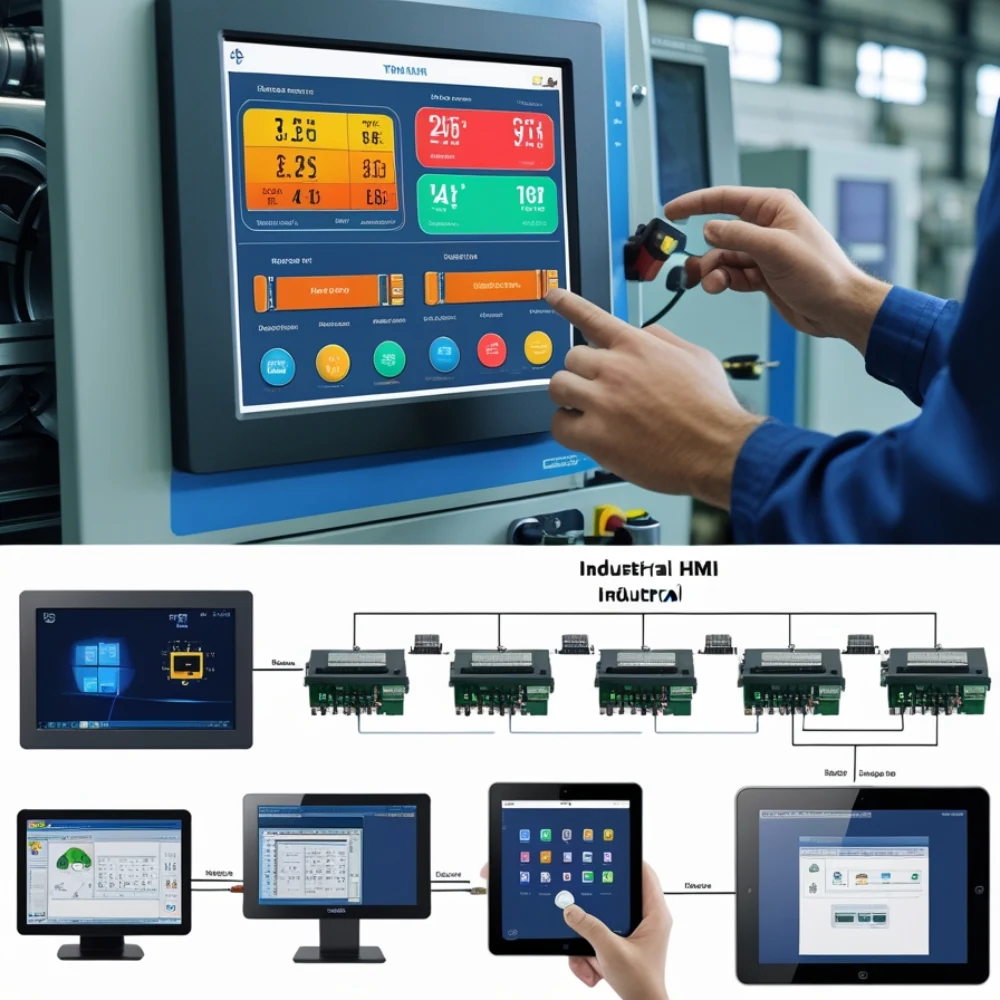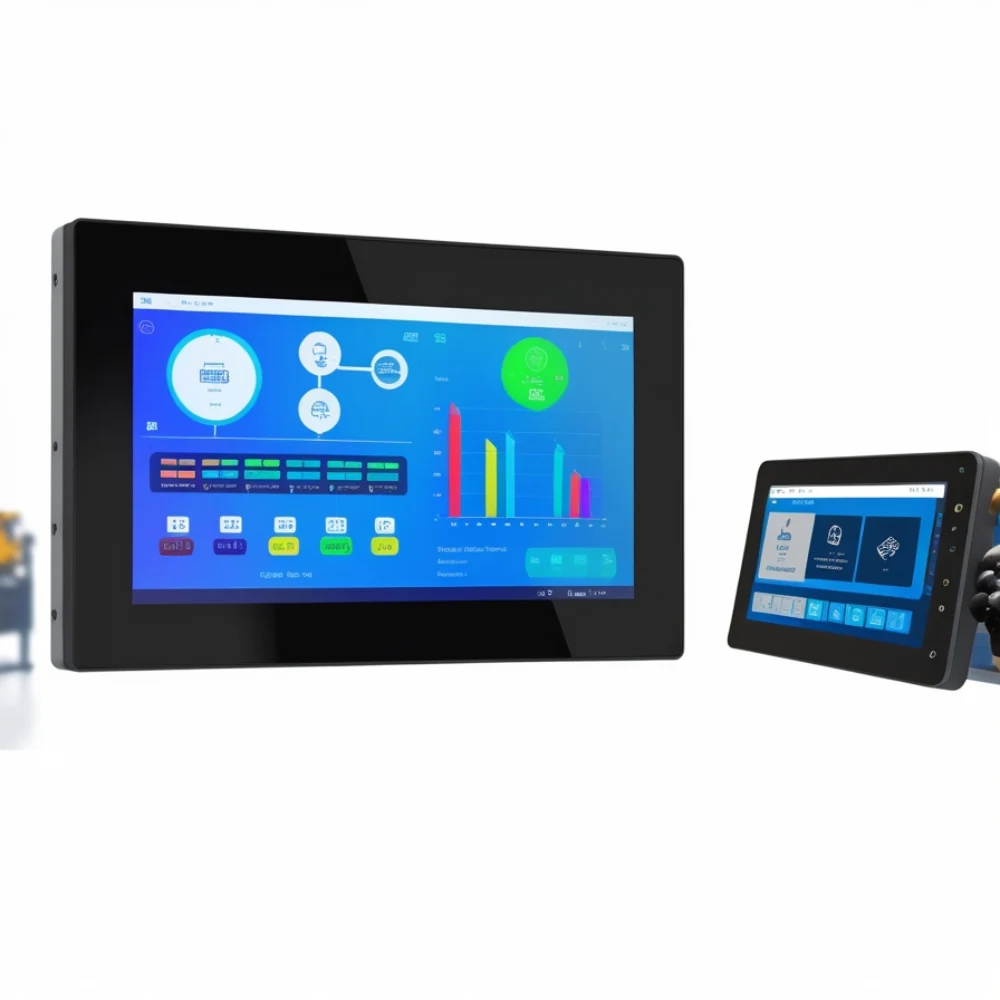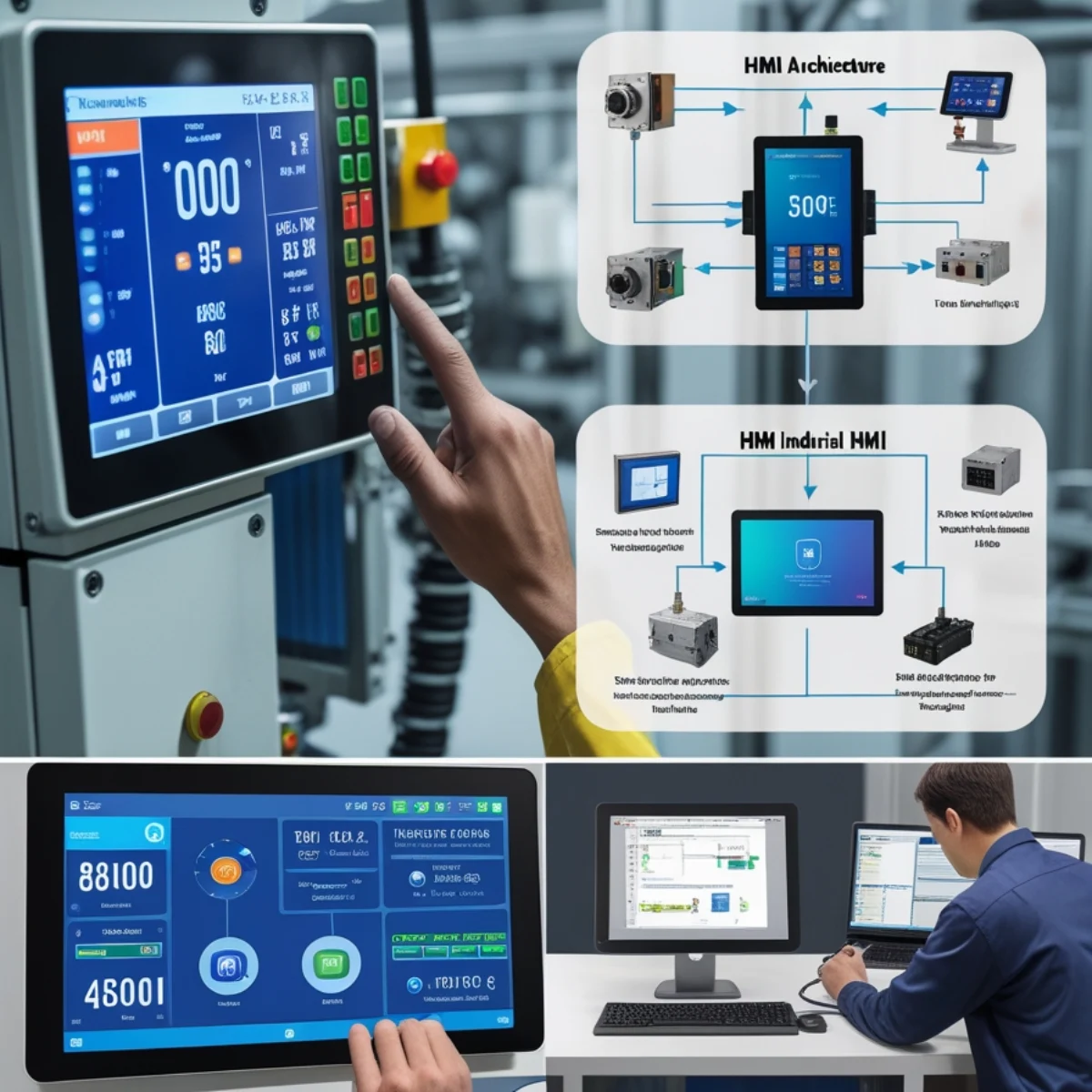Introduction
Imagine being able to see and control a big machine, like the ones in factories, right from a computer screen. That’s what industrial human-machine interfaces (HMIs) do! They act like a smart control panel that helps workers watch over machines, make adjustments, and fix problems quickly. In simple words, they help people and machines talk to each other. This guide will help you understand how these interfaces work, why they are important, and how to choose and set one up. Whether you are a student, a hobbyist, or a professional, this article will give you clear and easy-to-understand information.
What is an Industrial HMI?
An industrial HMI is a device that shows data from machines and lets people control them. Think of it as the screen on your phone, but made to work with heavy equipment like factory robots, pumps, or conveyor belts. It displays information like temperature, speed, and pressure so that workers can keep an eye on how machines are doing.

Amazon Feature
Key Features:
- Easy Control: You can use touch or buttons to send commands.
- Real-Time Monitoring: See machine data as it happens.
- Simple to Use: Designed for quick learning, even if you are new to automation.
- Strong Connection: Works with devices called PLCs (Programmable Logic Controllers) that manage machine operations.
- Integration with Software: Often works with special programs to help manage and store data.
How Does an Industrial HMI Work?
Industrial HMIs serve as a bridge between humans and machines. They receive data from the machines, process it, and show it in an easy-to-understand format. Here’s how they do it:
Main Components:
- Hardware:
- Display Panel: This is the screen where all the information is shown.
- Input Devices: These can be touchscreens or physical buttons used to send commands.
- Connection Ports: These help link the HMI to other devices, like PLCs.
- Display Panel: This is the screen where all the information is shown.
- Software:
- Operating System: Runs the HMI just like a computer.
- Interface Software: This displays data, such as graphs and alerts, in a way that is easy to understand.
- Communication Software: Helps the HMI talk to machines and controllers.
- Operating System: Runs the HMI just like a computer.

Communication Protocols:
The data exchange happens through special communication systems, including:
- EtherNet/IP: A fast way to connect many devices.
- Modbus: Common in many types of machines.
- Profibus: Often used for complex networks.
Imagine a teacher using a whiteboard to show important information. The HMI acts like that whiteboard, displaying data that helps workers understand what is happening with the machines.
Benefits of Using Industrial HMIs
Using industrial HMIs offers several big advantages. Let’s look at some of the most important ones:
Increased Efficiency
- Faster Decisions: With real-time data, workers can quickly spot problems.
- Smooth Control: Adjustments can be made on the fly, which keeps machines running better.
Enhanced Safety
- Fewer Errors: Easy-to-read data helps avoid mistakes.
- Better Alerts: The system can warn you if something goes wrong, making the workplace safer.
Real-Time Monitoring
- Instant Feedback: See live data to know how machines are performing.
- Preventative Maintenance: By spotting issues early, you can fix them before they become big problems.
Connectivity & Integration
- Works with Other Systems: HMIs connect well with PLCs, SCADA (Supervisory Control and Data Acquisition), and IoT (Internet of Things) solutions.
- Central Control: All data can be managed from one screen, which simplifies monitoring and control.
User-Friendly Interface
- Simple to Learn: The design is intuitive, so even beginners can get started quickly.
- Interactive: Touchscreens and easy menus make operation smooth and less stressful.
Types of Industrial HMIs
There are different types of industrial HMIs to meet various needs. Here are some common types:
Standalone HMIs
- Used for Single Machines: They work independently and are perfect for simple operations.
- Easy Setup: Often come preconfigured for specific tasks.
Embedded HMIs
- Built into Systems: These are integrated directly into the machinery.
- Real-Time Control: Ideal for monitoring complex processes.
PC-Based HMIs
- Customizable Software: They run on a computer and can be adapted to many different functions.
- Advanced Features: Often used in large-scale industrial setups.
Wireless & Cloud-Based HMIs
- Remote Access: Allow operators to monitor and control machines from different locations.
- Connected to the Internet: Useful for modern, smart factories.
How to Choose the Right HMIs for Your Needs
When choosing an HMI, here are some simple points to consider:
Screen Size & Resolution
- Big Screen: Good for complex tasks and detailed displays.
- Clear Image: Higher resolution makes it easier to see important details.
Ruggedness
- Built Tough: Must withstand dust, moisture, and extreme temperatures.
- Durability: Look for models that are designed for harsh industrial environments.

Compatibility
- Works with Your System: Ensure the HMI can easily connect with your existing PLCs and other software.
- Software Integration: Check if it supports your desired communication protocols.
Connectivity Options
- Multiple Ports: Look for support for Ethernet, USB, and wireless options.
- Flexible Setup: The more connectivity options, the better it can fit into your system.
Installation & Setup Guide
Setting up an industrial control panel (like an HMI) can be simple if you follow these steps:
Step-by-Step Setup:
- Mount the HMI: Secure it on a stable surface or panel.
- Connect Power & Cables: Plug in all the necessary cables correctly.
- Install the Software: Load the required operating and interface software.
- Configure Settings: Adjust the settings so the HMI communicates properly with the machines.
- Test & Calibrate: Check if the system works correctly and make any needed adjustments.
Common Mistakes to Avoid:
- Messy Wiring: Always organize cables properly to avoid loose connections.
- Outdated Software: Keep your firmware and software updated.
- Incorrect Configuration: Follow the manual closely to set up the right settings.
Troubleshooting Tips:
- If the screen does not respond, try recalibrating it.
- For communication issues, verify your network connections and update the firmware.
- If the system is slow, check for unnecessary logs or background tasks that may be slowing it down.
Best Brands & Where to Buy
Many trusted companies make these control panels. Here are a few top brands:
- Allen-Bradley: Known for reliability and seamless integration.
- Siemens: Offers a wide range of options for various industrial needs.
- Schneider Electric: Popular for user-friendly designs.
- Mitsubishi: Known for durable and efficient models.
You can find these products at industrial supply stores, online marketplaces like Amazon or Grainger, or through the manufacturers’ websites.
Frequently Asked Questions (FAQ)
It is a control panel that allows operators to monitor and control machines. It shows real-time data and helps in managing processes easily.
They connect through communication protocols such as EtherNet/IP, Modbus, and Profibus, linking with devices like PLCs.
They help increase efficiency, improve safety, provide real-time monitoring, and simplify control of complex systems.
Consider screen size, ruggedness, compatibility with your system, and available connectivity options.
Check your wiring, update the software, recalibrate the screen, and follow the troubleshooting tips in the manual.
Conclusion & Call-to-Action
Industrial human-machine interfaces make controlling and monitoring machines easier and more efficient. They are vital in modern manufacturing, process control, and automation. By understanding what they are, how they work, and what to look for when choosing one, you can make a smart decision for your operation or project.
If you want to learn more about these control panels or need expert advice on setting one up, don’t hesitate to explore the latest models or consult with an automation specialist. Your journey toward smarter, more efficient automation starts here!

